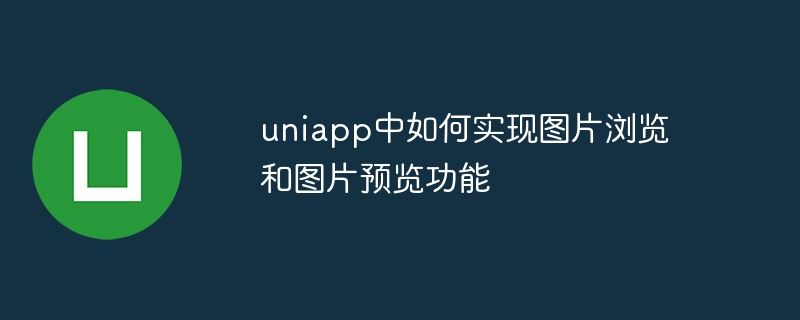 Web Front-end
Web Front-end
 uni-app
uni-app
 How to implement picture browsing and picture preview functions in uniapp
How to implement picture browsing and picture preview functions in uniapp
How to implement picture browsing and picture preview functions in uniapp

How to implement picture browsing and picture preview functions in uniapp?
在uniapp中,我们可以使用uni-ui组件库来实现图片浏览和图片预览功能。uni-ui是由DCloud公司开发的一套基于Vue.js的组件库,提供了丰富的UI组件,包括图片浏览和图片预览组件。
首先,我们需要在项目中引入uni-ui组件库。打开项目的pages.json文件,在"easycom"字段中添加"uni-ui",如下所示:
"easycom": {
"autoscan": true,
"custom": {
"^uni-(.*)": "@/uni-ui/uni-$1/uni-$1.vue"
}
}然后,在需要使用图片浏览和图片预览的页面中,引入相应的组件。打开页面的vue文件,在<template>标签中添加如下代码:
<template>
<view>
<!-- 图片列表 -->
<view v-for="(item, index) in images" :key="index" @click="previewImage(index)">
<image :src="item.url"></image>
</view>
<!-- 图片预览组件 -->
<uni-gallery :current="currentIndex" :urls="imageUrls" :show="{{previewVisible}}" @change="previewChange"></uni-gallery>
</view>
</template>在<script>标签中,添加如下代码:
<script>
import {uniGallery} from 'uni-ui'
export default {
components: {
uniGallery
},
data() {
return {
images: [
{url: '图片1的URL'},
{url: '图片2的URL'},
{url: '图片3的URL'}
],
currentIndex: 0, // 当前显示的图片索引
previewVisible: false // 是否显示图片预览
}
},
computed: {
imageUrls() {
return this.images.map(item => item.url) // 构建图片URL数组
}
},
methods: {
previewImage(index) {
this.currentIndex = index // 设置当前显示的图片索引
this.previewVisible = true // 显示图片预览
},
previewChange(e) {
this.currentIndex = e.detail.current // 图片预览切换事件处理
}
}
}
</script>上述示例代码中,首先定义了一个images数组,数组中包含了要显示的图片的URL。然后,在页面中使用v-for指令循环遍历images数组,渲染图片列表。当点击图片时,调用previewImage方法,设置currentIndex为点击图片的索引,并将previewVisible设为true,显示图片预览组件。
在uni-gallery组件中,current属性表示当前显示的图片索引,urls属性表示要预览的图片URL数组。通过点击切换图片时,会触发change事件,我们需要在previewChange方法中更新currentIndex。
以上就是使用uni-ui组件库实现图片浏览和图片预览功能的具体代码示例。通过这种方式,我们可以在uniapp中方便地实现图片相关的功能。
The above is the detailed content of How to implement picture browsing and picture preview functions in uniapp. For more information, please follow other related articles on the PHP Chinese website!

Hot AI Tools

Undresser.AI Undress
AI-powered app for creating realistic nude photos

AI Clothes Remover
Online AI tool for removing clothes from photos.

Undress AI Tool
Undress images for free

Clothoff.io
AI clothes remover

AI Hentai Generator
Generate AI Hentai for free.

Hot Article

Hot Tools

Notepad++7.3.1
Easy-to-use and free code editor

SublimeText3 Chinese version
Chinese version, very easy to use

Zend Studio 13.0.1
Powerful PHP integrated development environment

Dreamweaver CS6
Visual web development tools

SublimeText3 Mac version
God-level code editing software (SublimeText3)

Hot Topics
 1378
1378
 52
52
 How to start preview of uniapp project developed by webstorm
Apr 08, 2024 pm 06:42 PM
How to start preview of uniapp project developed by webstorm
Apr 08, 2024 pm 06:42 PM
Steps to launch UniApp project preview in WebStorm: Install UniApp Development Tools plugin Connect to device settings WebSocket launch preview
 Which one is better, uniapp or mui?
Apr 06, 2024 am 05:18 AM
Which one is better, uniapp or mui?
Apr 06, 2024 am 05:18 AM
Generally speaking, uni-app is better when complex native functions are needed; MUI is better when simple or highly customized interfaces are needed. In addition, uni-app has: 1. Vue.js/JavaScript support; 2. Rich native components/API; 3. Good ecosystem. The disadvantages are: 1. Performance issues; 2. Difficulty in customizing the interface. MUI has: 1. Material Design support; 2. High flexibility; 3. Extensive component/theme library. The disadvantages are: 1. CSS dependency; 2. Does not provide native components; 3. Small ecosystem.
 What basics are needed to learn uniapp?
Apr 06, 2024 am 04:45 AM
What basics are needed to learn uniapp?
Apr 06, 2024 am 04:45 AM
uniapp development requires the following foundations: front-end technology (HTML, CSS, JavaScript) mobile development knowledge (iOS and Android platforms) Node.js other foundations (version control tools, IDE, mobile development simulator or real machine debugging experience)
 What are the disadvantages of uniapp
Apr 06, 2024 am 04:06 AM
What are the disadvantages of uniapp
Apr 06, 2024 am 04:06 AM
UniApp has many conveniences as a cross-platform development framework, but its shortcomings are also obvious: performance is limited by the hybrid development mode, resulting in poor opening speed, page rendering, and interactive response. The ecosystem is imperfect and there are few components and libraries in specific fields, which limits creativity and the realization of complex functions. Compatibility issues on different platforms are prone to style differences and inconsistent API support. The security mechanism of WebView is different from native applications, which may reduce application security. Application releases and updates that support multiple platforms at the same time require multiple compilations and packages, increasing development and maintenance costs.
 Which is better, uniapp or native development?
Apr 06, 2024 am 05:06 AM
Which is better, uniapp or native development?
Apr 06, 2024 am 05:06 AM
When choosing between UniApp and native development, you should consider development cost, performance, user experience, and flexibility. The advantages of UniApp are cross-platform development, rapid iteration, easy learning and built-in plug-ins, while native development is superior in performance, stability, native experience and scalability. Weigh the pros and cons based on specific project needs. UniApp is suitable for beginners, and native development is suitable for complex applications that pursue high performance and seamless experience.
 What is the difference between uniapp and flutter
Apr 06, 2024 am 04:30 AM
What is the difference between uniapp and flutter
Apr 06, 2024 am 04:30 AM
UniApp is based on Vue.js, and Flutter is based on Dart. Both support cross-platform development. UniApp provides rich components and easy development, but its performance is limited by WebView; Flutter uses a native rendering engine, which has excellent performance but is more difficult to develop. UniApp has an active Chinese community, and Flutter has a large and global community. UniApp is suitable for scenarios with rapid development and low performance requirements; Flutter is suitable for complex applications with high customization and high performance.
 What component library does uniapp use to develop small programs?
Apr 06, 2024 am 03:54 AM
What component library does uniapp use to develop small programs?
Apr 06, 2024 am 03:54 AM
Recommended component library for uniapp to develop small programs: uni-ui: Officially produced by uni, it provides basic and business components. vant-weapp: Produced by Bytedance, with a simple and beautiful UI design. taro-ui: produced by JD.com and developed based on the Taro framework. fish-design: Produced by Baidu, using Material Design design style. naive-ui: Produced by Youzan, modern UI design, lightweight and easy to customize.




